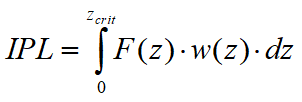The liquefaction potential index LPI is a measure of the liquefaction effects based on the width and depth of the liquefiable areas and on historical cases of liquefaction.
The methods implemented in LIQUITER for the calculation of the liquefaction potential LPI are: Iwasaki et al. (1982) and Sonmez (2003).
The calculation of the liquefaction potential index is defined by:

Iwasaki
F(z) is function of the safety factor that for:
![]()
![]()
Sonmez
![]()
![]()
![]()
Is indicated with zcrit the maximum depth to which liquefied layers produce effects in surface:
![]()
![]()
Traditionally, the critical depth is assumed to be 20 m, but recently Ozocak and Sert (2010), based on experimental evidence successive to earthquakes in Adapazari (Turkey) in 1999 and based on the limit curves for manifestations of surface liquefaction in Ishihara (1985), have proposed to take for earthquakes of "usual" magnitude the critical depth of 10 m.
The classes of liquefaction potential, according to the proposal Sonmez (2003), are the following:
LPI |
Liquefaction potential |
|---|---|
0 |
Non liquefiable |
0<LPI≤2 |
Low |
2<LPI≤5 |
Moderate |
5<LPI≤15 |
High |
LPI>15 |
Very high |
© Geostru